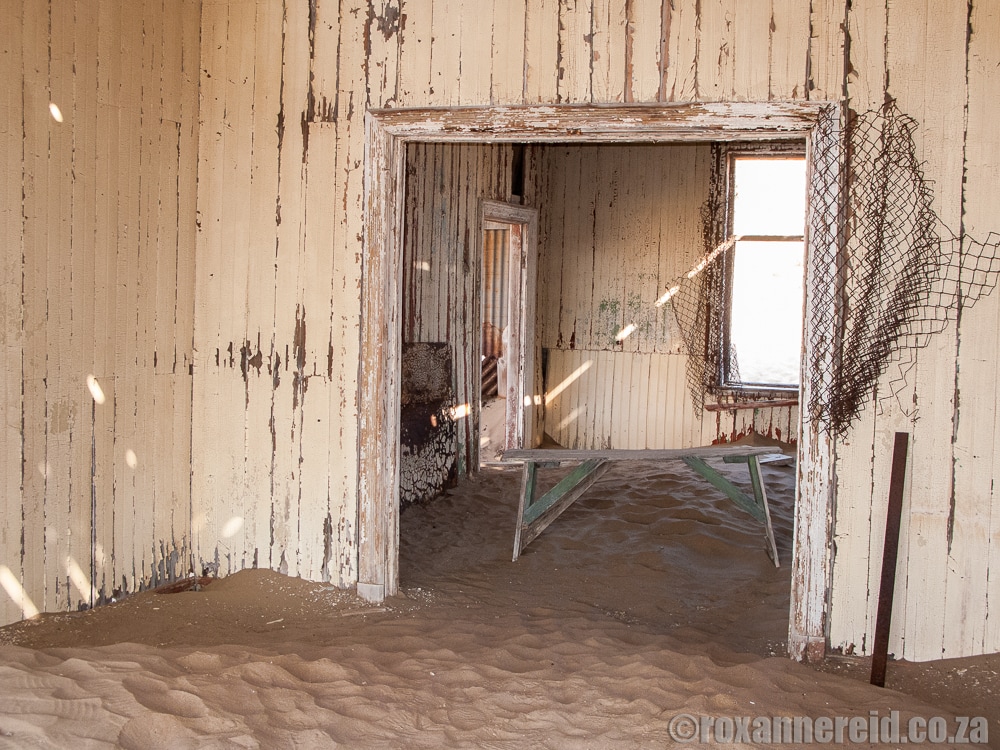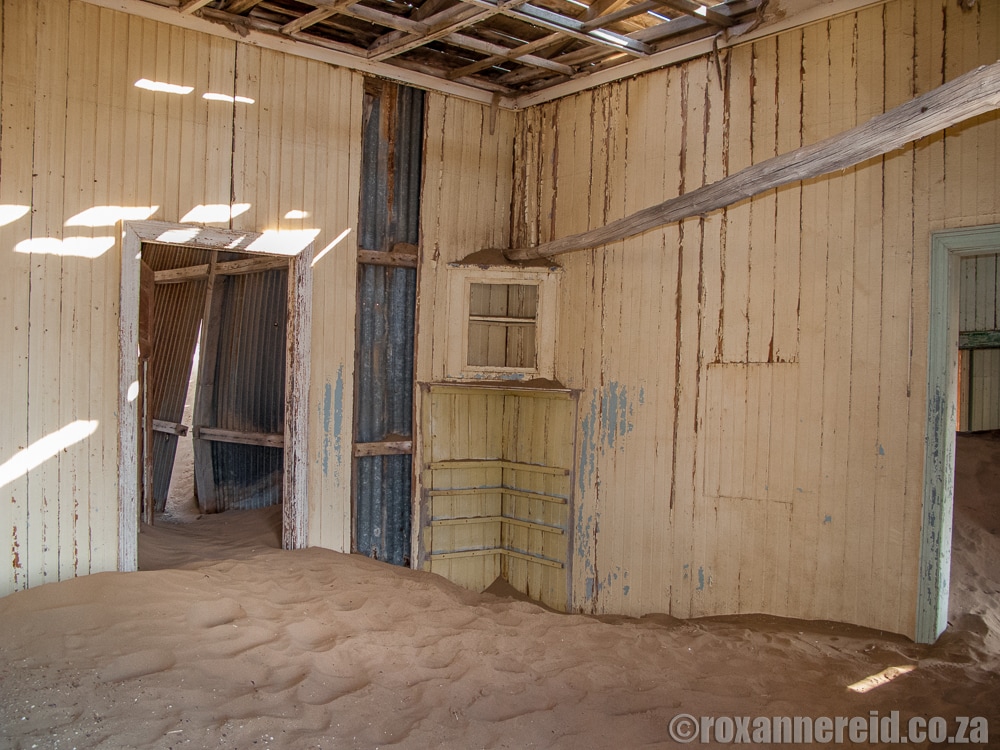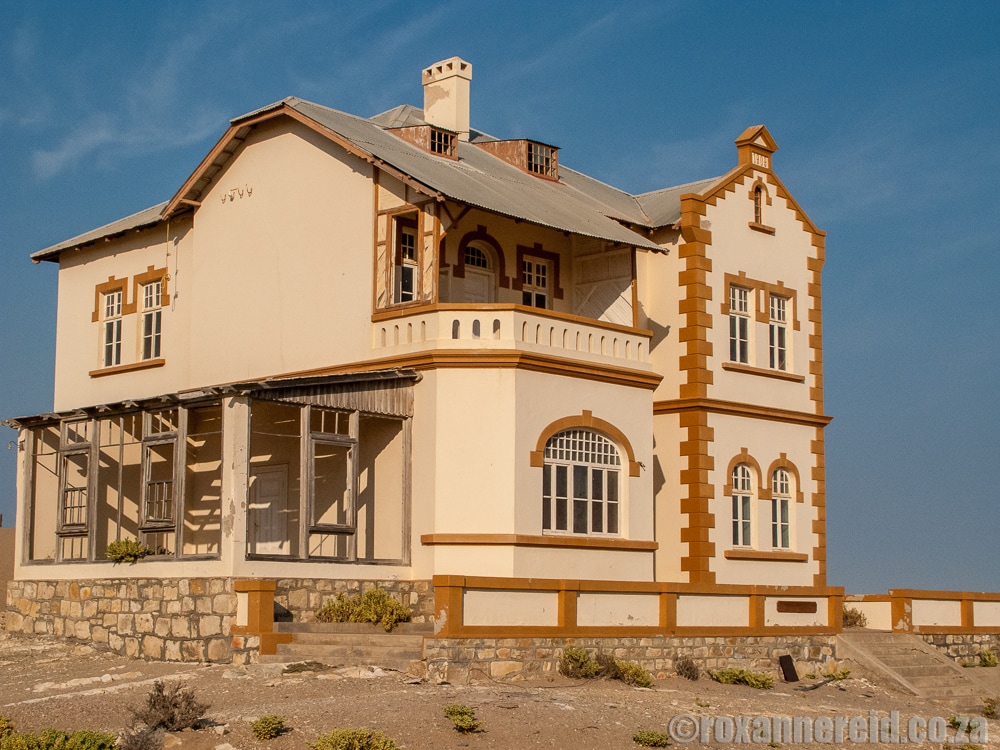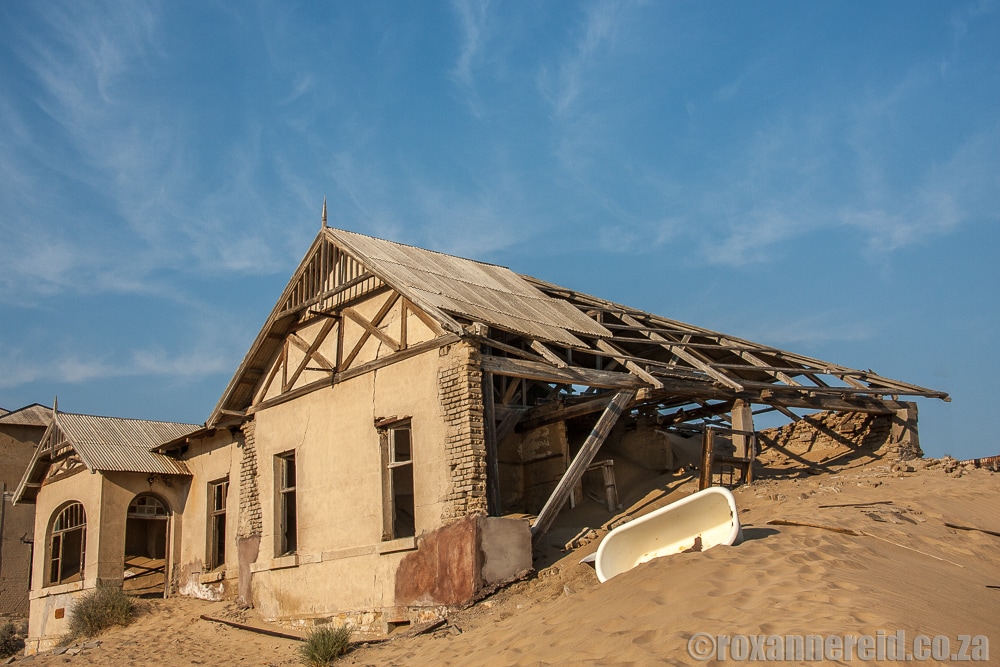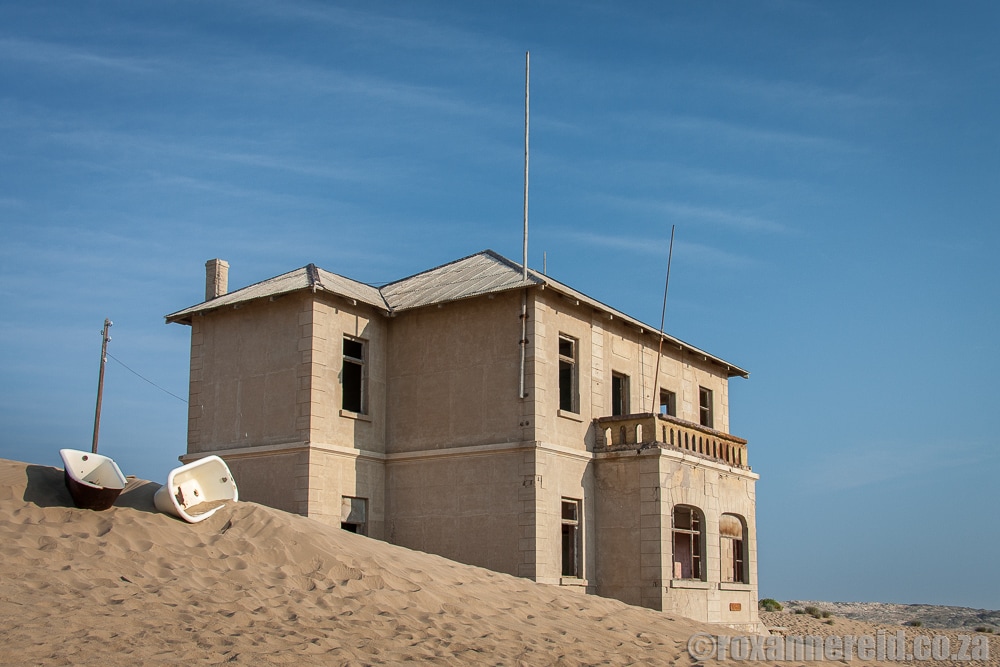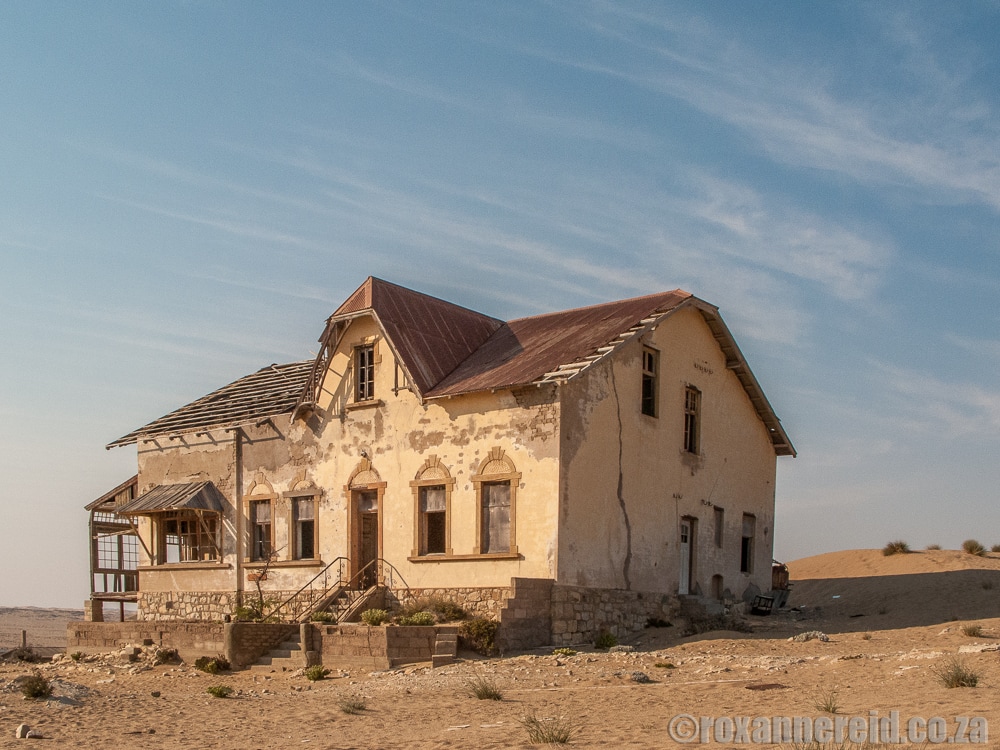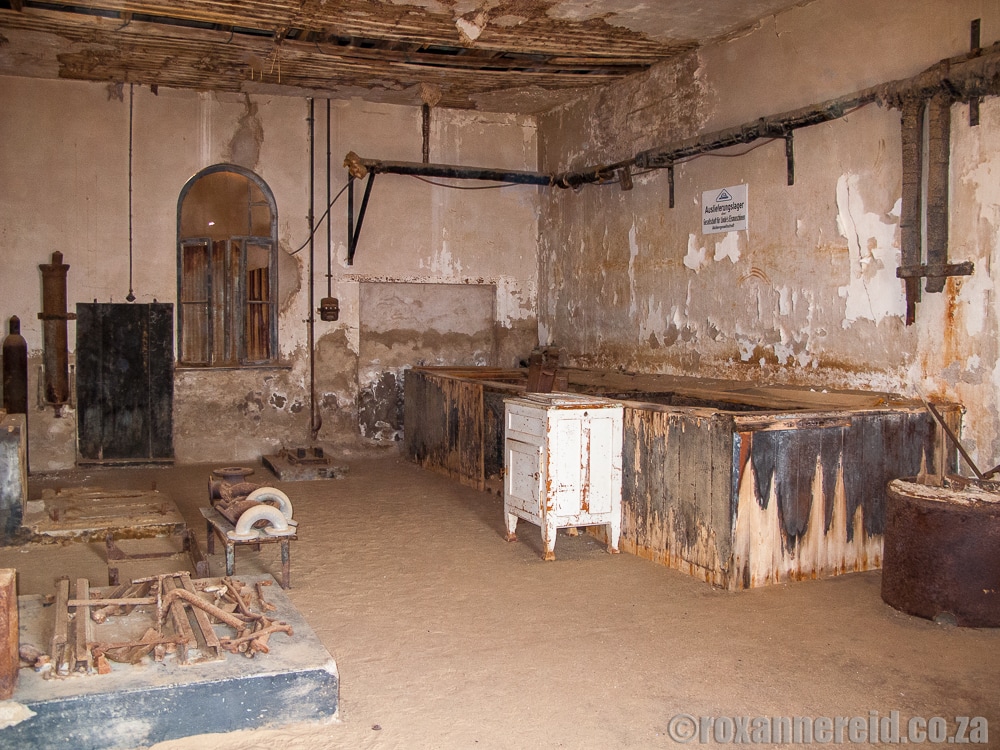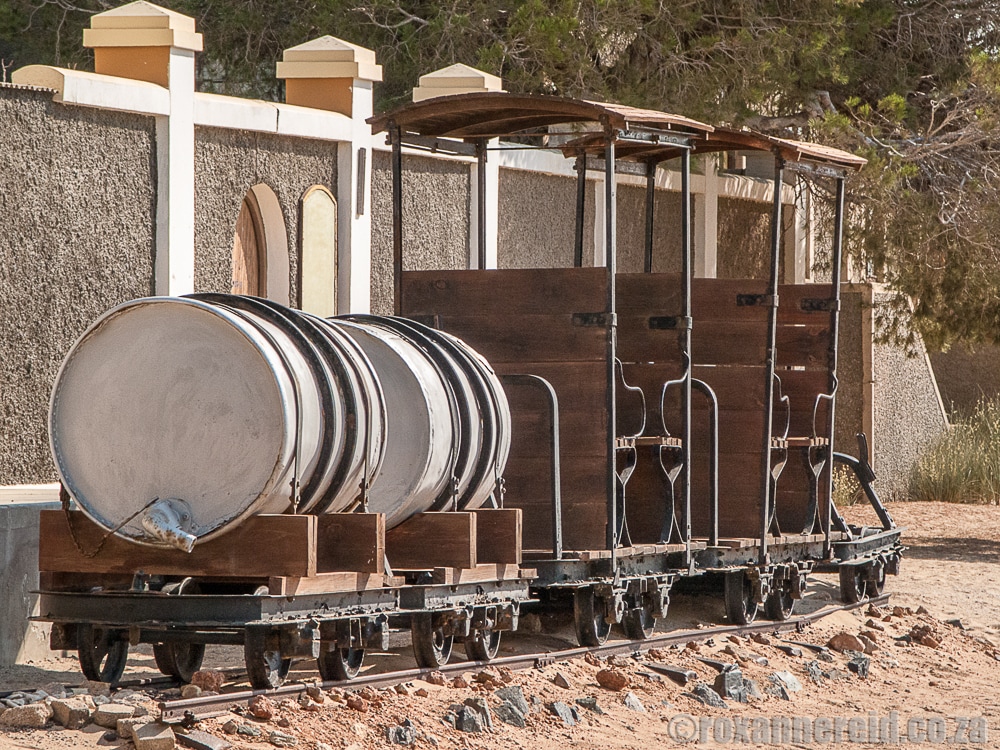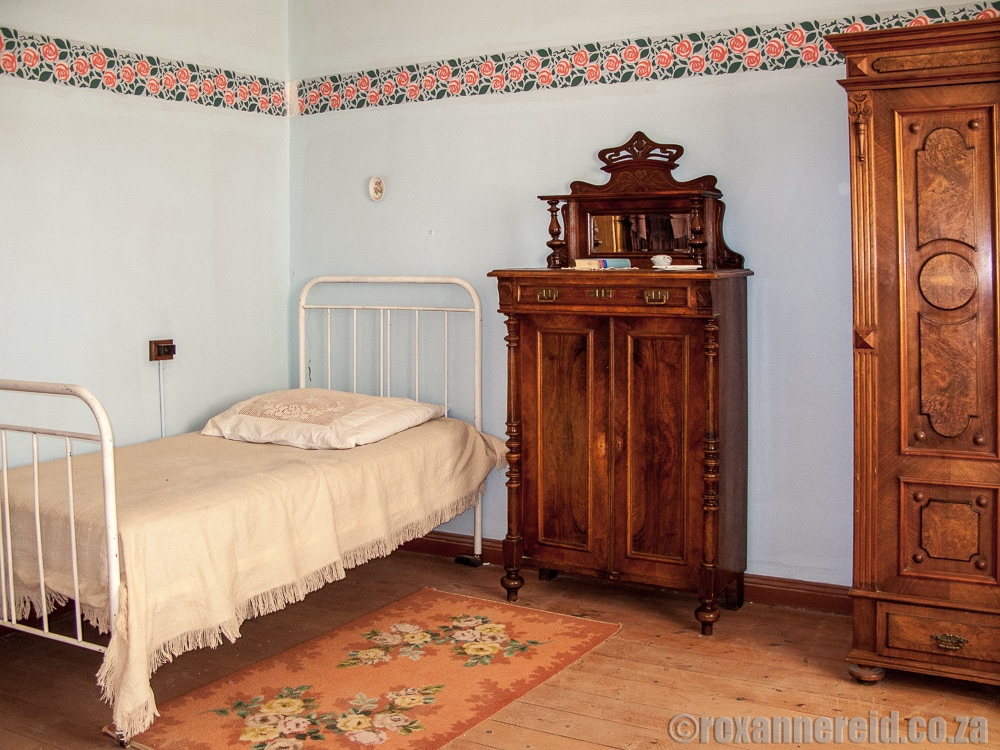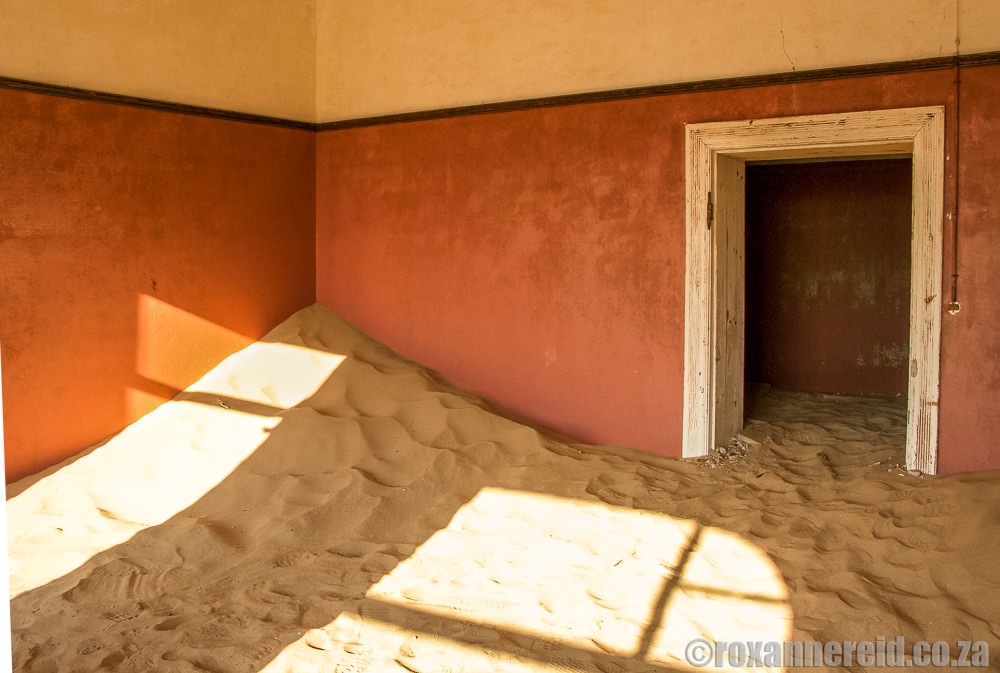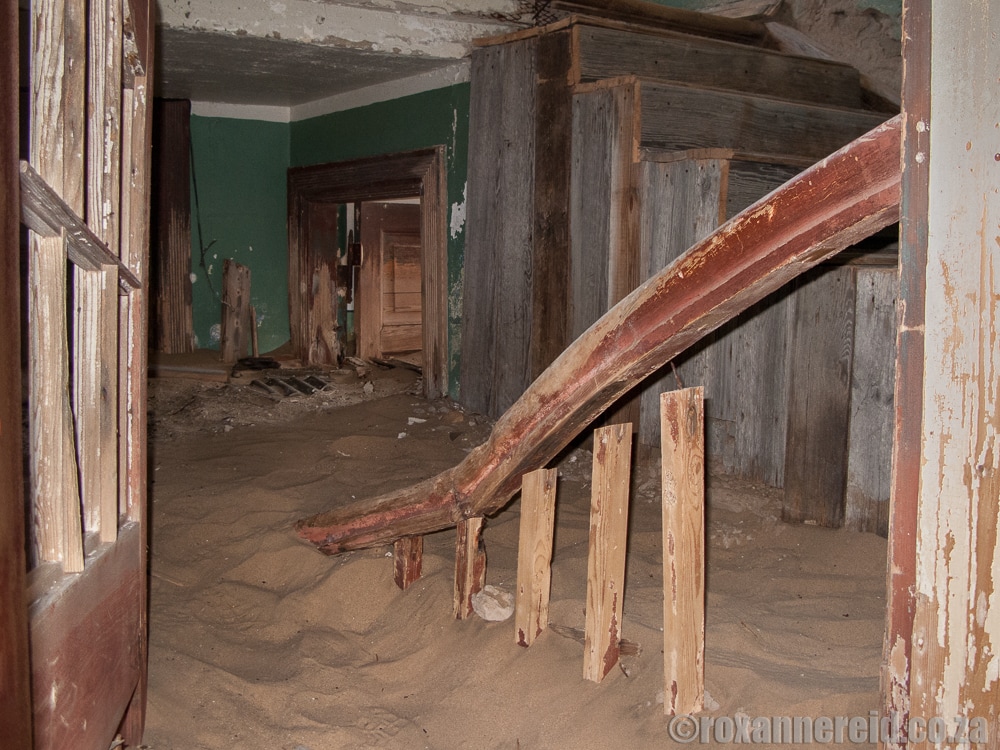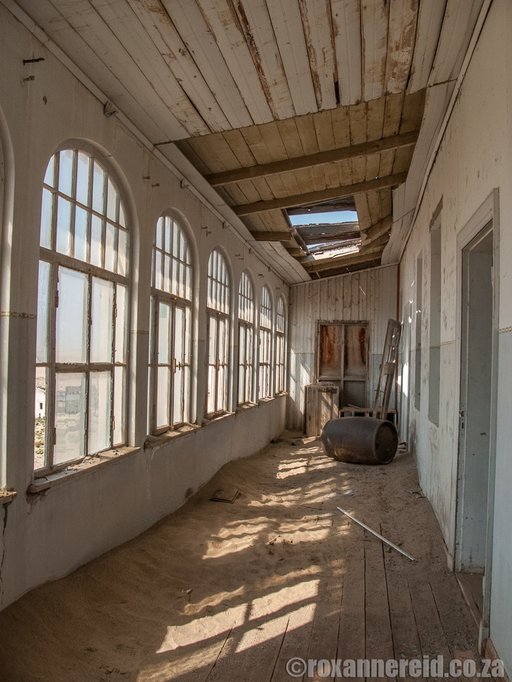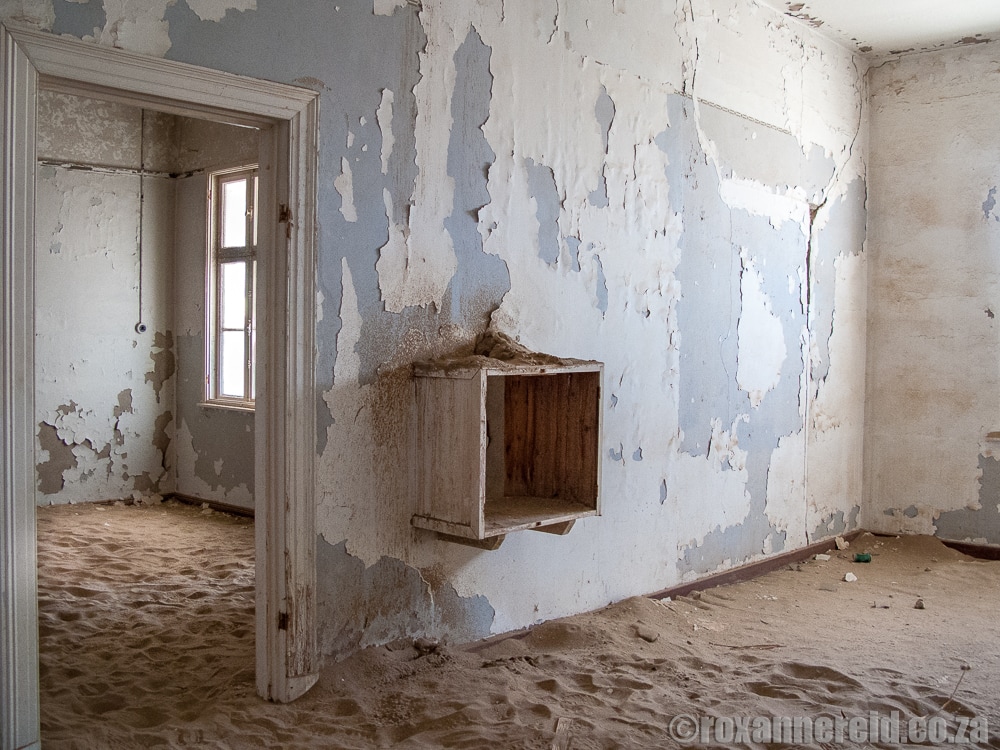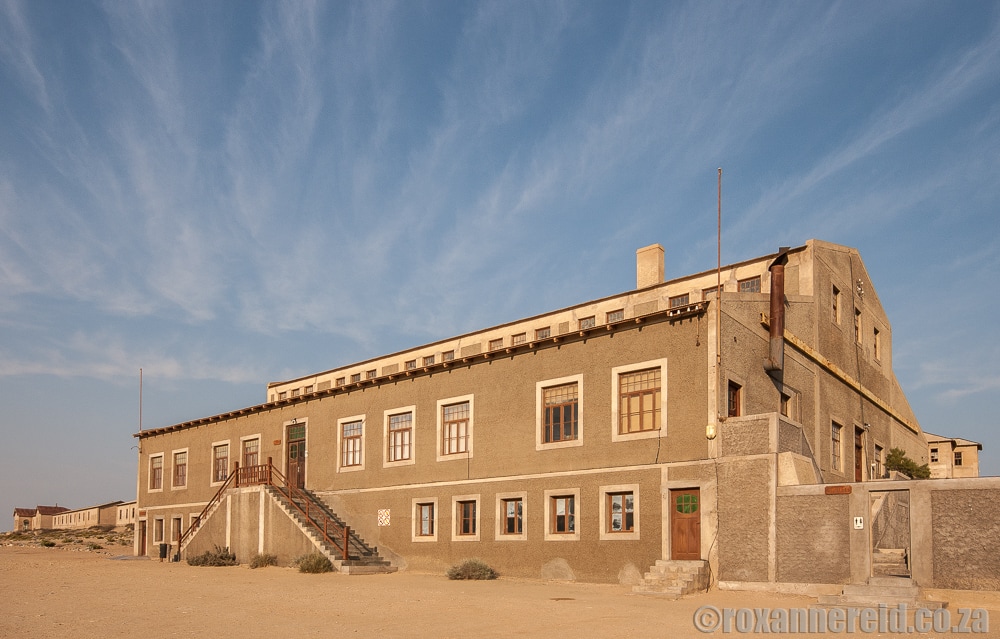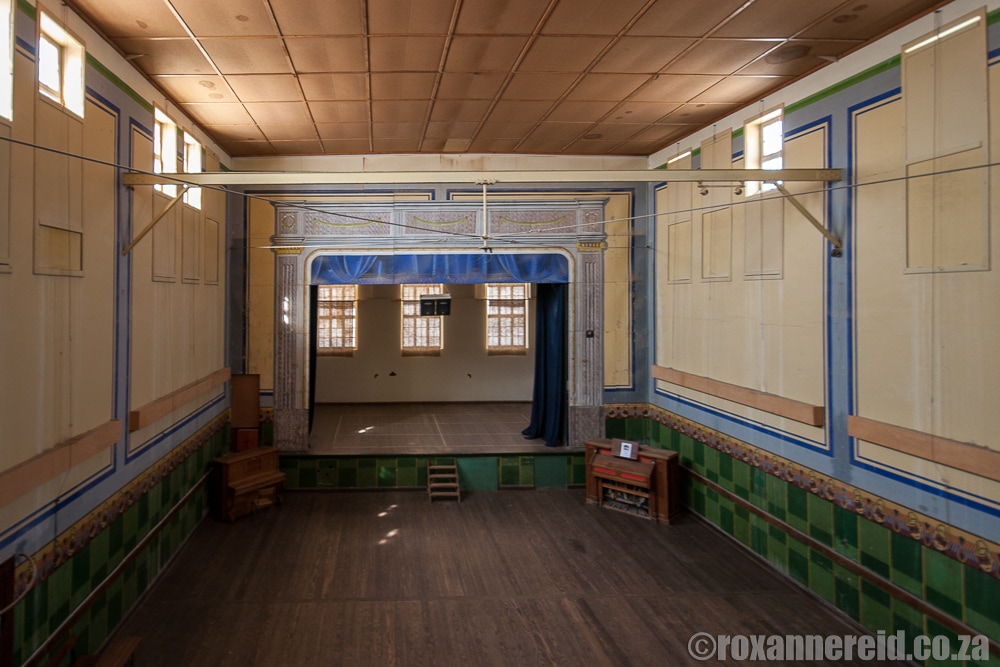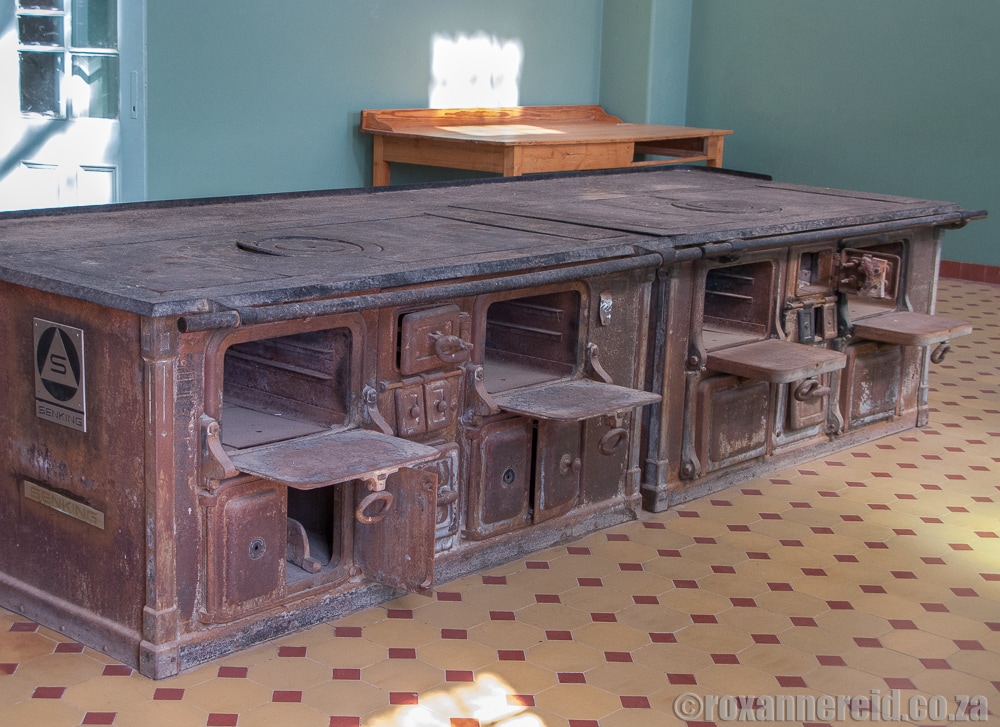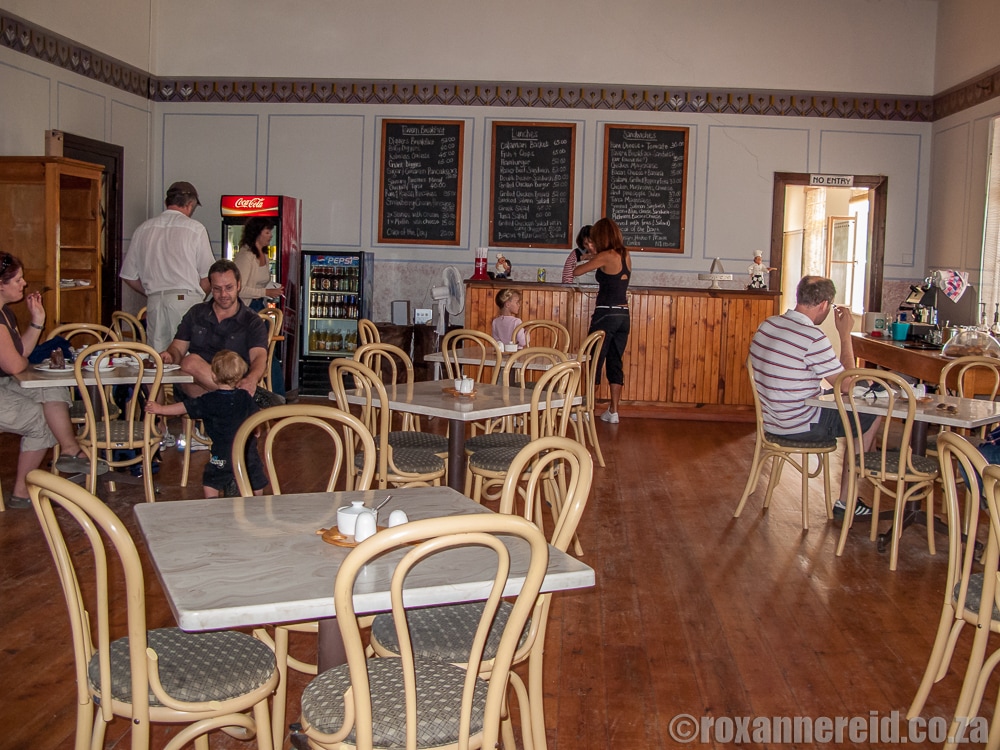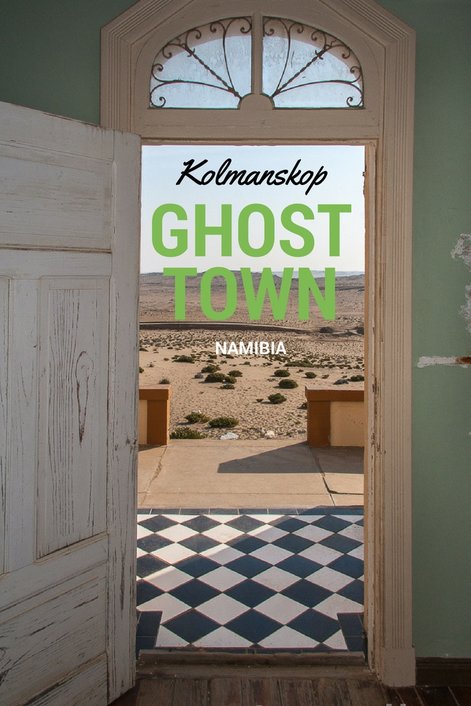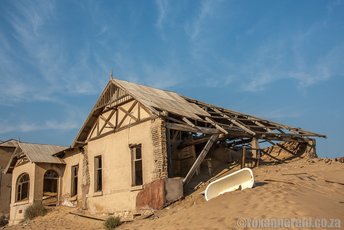
By Roxanne Reid
I’ve talked before about how diamonds at Kolmanskop were so plentiful in the early 1900s that you could pluck them by the fistful off the open ground. The boom didn’t last long, but during its heyday some 1300 people lived and worked here. Today past and present collide with haunting magnetism at Kolmanskop ghost town in Namibia.
I’ve talked before about how diamonds at Kolmanskop were so plentiful in the early 1900s that you could pluck them by the fistful off the open ground. The boom didn’t last long, but during its heyday some 1300 people lived and worked here. Today past and present collide with haunting magnetism at Kolmanskop ghost town in Namibia.
Those were the glory days when Kolmanskop had its own transformer station, creating electricity by burning coal that was shipped to Lüderitz from Germany. So despite its isolation, the town had electricity from 6:00 till 17:00, but not in the evenings and weekends. Obviously power was important for the diamond works and other business, but less important for people’s private lives.
The Germans who lived here during the boom years had substantial houses, especially the architect, engineer and mine manager, whose plush double story was restored and is in relatively good condition.
Our guide Netley Beukes said the most photographed house was that of the teacher, who the architect must have disliked. In the teeth of the wind, its one whole side had been ripped away and the house was almost entirely filled with sand. By contrast, the shrewd architect’s house was built more solidly and out of the path of the wind.
Our guide Netley Beukes said the most photographed house was that of the teacher, who the architect must have disliked. In the teeth of the wind, its one whole side had been ripped away and the house was almost entirely filled with sand. By contrast, the shrewd architect’s house was built more solidly and out of the path of the wind.
Not far away the engineer’s house had two tree stumps outside it. Netley told us these used to be flourishing green trees a hundred years ago. How did they grow here in the desert?
‘Well, the engineer planned and laid the water pipes so he was able to build his house right next to them, and he drilled a little hole that “leaked” water to his house,’ she said. The story goes that he had two beautiful daughters, and it was said that they could ‘turn a desert into a garden’.
I couldn’t help noticing that the bachelors’ quarters, in what was called the ‘Bull’s convent’, were almost next door – and I wondered how much the engineer worried about having them so close to his lovely daughters.
‘Well, the engineer planned and laid the water pipes so he was able to build his house right next to them, and he drilled a little hole that “leaked” water to his house,’ she said. The story goes that he had two beautiful daughters, and it was said that they could ‘turn a desert into a garden’.
I couldn’t help noticing that the bachelors’ quarters, in what was called the ‘Bull’s convent’, were almost next door – and I wondered how much the engineer worried about having them so close to his lovely daughters.
It must have been a harsh and lonely life for some 40 children who lived here, especially since pets would have been hard to keep in these desert conditions. But there’s a story of one family who had a pet ostrich – a creature already well-adapted to the hot, dry conditions. It bullied the residents and the only time anyone thought it was a remotely good idea was one Christmas when it pulled a sled carrying Father Christmas across the sand.
I felt the sadness oozing from beautiful homes that were falling apart, abandoned and no longer loved. Drifts of sand edged doors open, thirsty woodwork cracked and peeled, broken windows gazed out into the desert. All was silent but for the odd rumble from the main road as a truck passed on its way to Lüderitz, and a lonely bird that chirped briefly from a sand dune and then was gone.
I felt the sadness oozing from beautiful homes that were falling apart, abandoned and no longer loved. Drifts of sand edged doors open, thirsty woodwork cracked and peeled, broken windows gazed out into the desert. All was silent but for the odd rumble from the main road as a truck passed on its way to Lüderitz, and a lonely bird that chirped briefly from a sand dune and then was gone.
All the trappings of a busy little town
Looking at Kolmanskop now it’s hard to believe that it was once a bustling little town with a post office, police station, entertainment hall, school, hospital, general dealer, baker, lemonade factory and butcher. The butcher got his meat from farms nearby, though here in no man’s land ‘nearby’ was actually a hefty 140km away.
A huge rectangular rusted steel tank used to hold seawater for washing the diamonds and for the ice factory, which also made lemonade. The tank doubled as a swimming pool on the weekends.
Electricity and ammonia gas at the ice factory cooled the sea water so that ‘forms’ of fresh water immersed in it would freeze. Each house got half a block of ice a day for their ice-boxes. Cooled sea water was continuously pumped through pipes that cooled the butchery’s cool room on the other side of the wall.
Looking at Kolmanskop now it’s hard to believe that it was once a bustling little town with a post office, police station, entertainment hall, school, hospital, general dealer, baker, lemonade factory and butcher. The butcher got his meat from farms nearby, though here in no man’s land ‘nearby’ was actually a hefty 140km away.
A huge rectangular rusted steel tank used to hold seawater for washing the diamonds and for the ice factory, which also made lemonade. The tank doubled as a swimming pool on the weekends.
Electricity and ammonia gas at the ice factory cooled the sea water so that ‘forms’ of fresh water immersed in it would freeze. Each house got half a block of ice a day for their ice-boxes. Cooled sea water was continuously pumped through pipes that cooled the butchery’s cool room on the other side of the wall.
Sea water was piped from Elisabeth Bay to be desalinated as a supplement to fresh water brought in barrels from a borehole at Garub 100km to the east. By the 1930s the town brought in about 1000 tons of drinking water a month from Cape Town. It was shipped to Lüderitz then carried by mule train to Kolmanskop and pumped into storage tanks.
Each person was allowed 20 litres of water a day free; if you needed more you had to buy it yourself – at half the price of beer. For the wealthier residents, the water could create small patches of lawn and garden to keep the dust down. To tempt people to work and live here, wages were good and almost everything was free, from company housing to milk deliveries, even the services of a sweeping team to keep the streets from becoming shrouded in drifting sand.
Each person was allowed 20 litres of water a day free; if you needed more you had to buy it yourself – at half the price of beer. For the wealthier residents, the water could create small patches of lawn and garden to keep the dust down. To tempt people to work and live here, wages were good and almost everything was free, from company housing to milk deliveries, even the services of a sweeping team to keep the streets from becoming shrouded in drifting sand.
The town had a taxi on rails pulled by six mules. It carried water in big drums around to all the houses and also delivered bread. You could catch a ride, sitting on one of the little wooden benches. ‘One man could step on to it just outside his house and it would take him directly to his office so he didn’t need to get his shoes filled with sand,’ said Netley.
The old general dealer shop is now a museum, with its original massive wooden counter. The ledger shows purchases like caviar, chocolate and camembert cheese, so people here certainly weren’t doing without the luxuries of a civilised life.
‘The shop-owner was one of the richest women in Kolmanskop because if you didn’t have money you could pay her in diamonds,’ said Netley. The shopkeeper’s house alongside is furnished with items that were dug out of the sand from around Kolmanskop.
‘The shop-owner was one of the richest women in Kolmanskop because if you didn’t have money you could pay her in diamonds,’ said Netley. The shopkeeper’s house alongside is furnished with items that were dug out of the sand from around Kolmanskop.
Hospital, school, church
The hospital on the edge of the little settlement could take 200 patients. It had the first x-ray machine in southern Africa, but it was brought here more in case you spiced up your lunch with a few diamonds than for any medical benefit. Two German doctors and four nurses were on hand. Rumour has it that one of the doctors was popular for his habit of prescribing an evening tonic of champagne and caviar sandwiches.
The hospital on the edge of the little settlement could take 200 patients. It had the first x-ray machine in southern Africa, but it was brought here more in case you spiced up your lunch with a few diamonds than for any medical benefit. Two German doctors and four nurses were on hand. Rumour has it that one of the doctors was popular for his habit of prescribing an evening tonic of champagne and caviar sandwiches.
But those days are long gone. What we found was a derelict but still elegant building, with lovely long porches and high arched windows. Sand piled up in the corners of the wards, but sunlight peeped in through rickety ceilings. In places holes in the walls allowed us to see from one room through to the next, making for interesting photos and perspective effects.
The little school had fewer than 40 kids and the school hall was used for church services twice a month, when pastors used to come from Lüderitz. Although the pianist was Catholic she played for all services, no matter the denomination. But why didn’t they build a church? Apparently they resisted this idea because it would make the settlement ‘permanent’.
The irony of their solidly built houses, hospital and entertainment hall apparently eluded them.
Entertainment hall and skittle alley
In a desert wasteland far from their homes in Germany, the townsfolk would obviously need something to entertain them if they weren’t to get into trouble for the wrong sort of activities that flourished in so many other early diamond towns. Think drunken debauchery, gambling and prostitution, for instance.
The irony of their solidly built houses, hospital and entertainment hall apparently eluded them.
Entertainment hall and skittle alley
In a desert wasteland far from their homes in Germany, the townsfolk would obviously need something to entertain them if they weren’t to get into trouble for the wrong sort of activities that flourished in so many other early diamond towns. Think drunken debauchery, gambling and prostitution, for instance.
Cue the entertainment hall, its steel framework prefabricated and imported from Germany. The theatre is still in good condition with the interior paintwork and decorations intact. The acoustics are so fine that visitors today are encouraged to put them to the test by bursting into song.
And don’t think the entertainment was all about Oompah bands. The mine paid for opera companies to be shipped from Europe to perform here, and the hall was used by the local orchestra, theatre group, cinema and gymnastics troop. There’s a skittle alley too, with its original bar and old ice box, its stencilled frieze of skittles.
A kitchen with a giant coal stove used to prepare 380 meals a day, and ropes hung from the ceiling at each table in the restaurant so you could ring for service. There was a champagne bar for the ladies (no gents allowed in except to pay) and a cigar room for the gents (no ladies allowed). Today a restaurant serving light meals occupies the old champagne bar where we enjoyed good scones and pancakes.
Allow enough time
You can do a 60-minute guided tour at Kolmanskop, Mondays to Saturdays at 9:30 and 11:00, Sundays and public holidays at 10:00. Or you can pay your entrance fee and wander around on your own. We did both and were so engrossed in history, ripples of light and shadow, sand-packed buildings and forgotten dreams that four or five hours were gobbled up before we noticed.
Don’t come in a hurry. You’ll probably only visit once in your life so take some time to go into the buildings, soak up the atmosphere and think about the people who used to live and work here. Try to imagine what it must have been like when children ran and played in this monster sandpit, when women in long dresses enjoyed a show in the theatre or local workers dreamt of keeping just one or two diamonds for themselves, when people laughed and cried and made a life here.
Did you find the article interesting? Pin this image!
You can do a 60-minute guided tour at Kolmanskop, Mondays to Saturdays at 9:30 and 11:00, Sundays and public holidays at 10:00. Or you can pay your entrance fee and wander around on your own. We did both and were so engrossed in history, ripples of light and shadow, sand-packed buildings and forgotten dreams that four or five hours were gobbled up before we noticed.
Don’t come in a hurry. You’ll probably only visit once in your life so take some time to go into the buildings, soak up the atmosphere and think about the people who used to live and work here. Try to imagine what it must have been like when children ran and played in this monster sandpit, when women in long dresses enjoyed a show in the theatre or local workers dreamt of keeping just one or two diamonds for themselves, when people laughed and cried and made a life here.
Did you find the article interesting? Pin this image!
You may also enjoy
Kolmanskop: why to visit Namibia's ghost town
More about Namibia
Copyright © Roxanne Reid - No words or photographs on this site may be used without permission from roxannereid.co.za
Kolmanskop: why to visit Namibia's ghost town
More about Namibia
Copyright © Roxanne Reid - No words or photographs on this site may be used without permission from roxannereid.co.za
